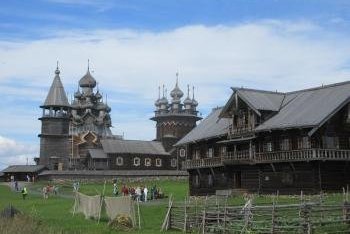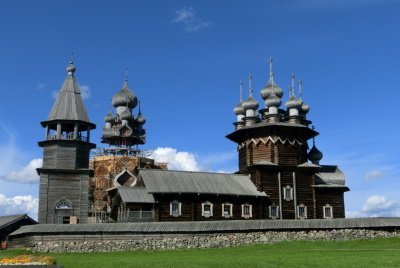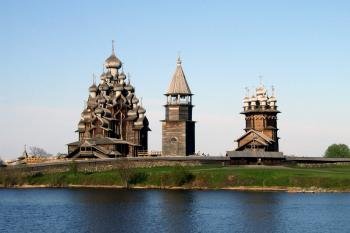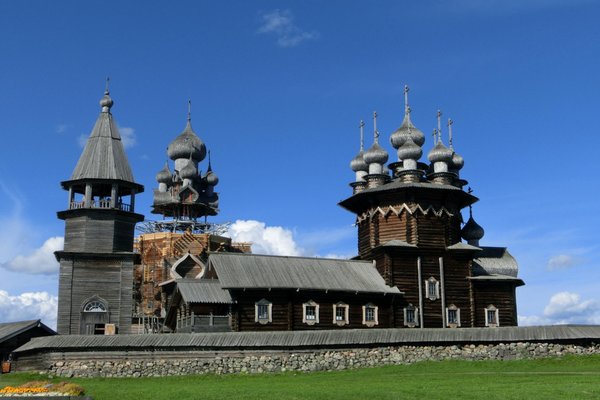Russia
Kizhi Pogost
Kizhi Pogost is an enclosure with religious buildings typical for sparsely populated Orthodox communities.
The two 18th-century wooden churches and an octagonal wooden bell tower from the 19th century are located on an island in Lake Onega in Karelia. One of the churches was used only in summer, the other only in winter. The fully wooden structures blend in perfectly with the surrounding landscape.
Community Perspective: “Iconic… Kizhi’s striking shapes, magnificent craftsmanship and wonderful location lift them way out”. It receives a lot of visitors and can be reached via a 75-minute hydrofoil journey from Petrozavodsk (see tips from Wojciech) or on a cruise (as Solivagant did).
Site Info
Official Information
- Full Name
- Kizhi Pogost (ID: 544)
- Country
- Russia
- Status
-
Inscribed 1990
Site history
History of Kizhi Pogost
- 1990: Inscribed
- Inscribed
- Type
- Cultural
- Criteria
- i
- iv
- v
Links
- UNESCO
- whc.unesco.org
- Official
-
- kizhi.karelia.ru — Kizhi Pogost
All Links
UNESCO.org
- whc.unesco.org — whc.unesco.org/
Official Website
- kizhi.karelia.ru — Kizhi Pogost
News Article
- July 19, 2021 theartnewspaper.com — Kizhi Pogost church is finally restored on Russian island of remarkable wooden buildings
Community Information
- Community Category
- Religious structure: Christian
Travel Information
Recent Connections
-
Untranslated Toponyms
"Pogost (Russian: погост, from Old East… -
Foreigner prices
880R versus 330R -
Built in the 18th century
Transfiguration Church (1714), Interces…
Connections of Kizhi Pogost
- Geography
-
-
Full White Nights
-
Notable lakes
On the banks of Lake Onega, the 2nd largest lake in Europe and 18th in the world
-
- Trivia
-
-
In Video Games
Age of Empires II: Slavs: Church on Kiži Island
-
- History
-
-
Been part of independent Finland (de facto)
Finnish army occupied the area of Petrozavodsk and Olonets Karelia in 1941, including the peninsula and island of Kizhi. The area was held by Finnish forces until 1944. The area of Kizhi was front line and the furthest place Finnish army advanced during the Continuation War. There is even a legend that Finnish bombers didn't want to drop bombs to Kizhi Pogost.
-
- Architecture
-
-
Domes
the 22-domed Transfiguration Church -
Wooden architecture
-
No Nails
-
- World Heritage Process
-
-
Perfect Inscriptions
1990
-
- Constructions
- WHS on Other Lists
-
-
World Monuments Watch (past)
Kizhi Pogost, Lake Onega (1996)
-
- Timeline
-
-
Built in the 18th century
Transfiguration Church (1714), Intercession Church (1764)
-
- Visiting conditions
-
-
Foreigner prices
880R versus 330R
-
- WHS Names
-
-
Untranslated Toponyms
"Pogost (Russian: погост, from Old East Slavic: погостъ) is a historical term with several meanings in the Russian language...... The original usage applies to the coaching inn for princes and ecclesiastics with the word being similar to modern Russian gost' (гость), "guest". It is assumed that originally pogosts were rural communities on the periphery of the ancient Rus` state, as well as trading centers..... In the end of the 10th century pogosts transformed into administrative and territorial districts" (Wiki) Other examples of the word include e.g Porzhensky Pogost, which is within Russia's T List site "Testament of Kenozero Lake"See en.wikipedia.org
-
News
- theartnewspaper.com 07/19/2021
- Kizhi Pogost church is finally res…
Recent Visitors
Visitors of Kizhi Pogost
- Alexander Barabanov
- Alexander Lehmann
- A. Mehmet Haksever
- Ana Lozano
- arina_soboleva
- Atila Ege
- Christer Sundberg
- Delphine Delaunay
- disnsam
- Fan Yibo
- giloudepuertorico
- Harald T.
- Iain Jackson
- Ingemar Eriksson
- Ivan Rucek
- Jarek Pokrzywnicki
- Jeanne OGrady
- Jonas Kremer
- KarenBMoore
- Lithobates
- Malgorzata Kopczynska
- Marcobrey
- Martina Rúčková
- maryhattie
- Mikko
- Mikko Syrjä
- Milan Jirasek
- MMM
- Nihal Ege
- Olli-Pekka Turunen
- Roman Bruehwiler
- Sergio Arjona
- Solivagant
- Stan
- Szucs Tamas
- Tamara Ratz
- Tatiana Nikulnikova
- Tikhon Puliaev
- Tinamu
- viktor_balandin
- Vsacan
- Wojciech Fedoruk
- Yevhen Ivanovych
- Zizmondka
Community Reviews
Show full reviews
Petrozavodsk seems to be a good base for visiting at least two WHS and one TWHS. There are one-day trips to TWHS Valaam Archipelago and even Solovetsky Islands (full trip takes 28 hours only, which is most probably the easiest way to visit these remote monasteries). And of course it is the best (the only?) starting point to visit one of Northern Russia’s highlights – Kizhi Pogost. There are several speed boats shuttling between Petrozavodsk and Kizhi, but during summer almost all of them are fully booked – if you are coming in a bigger group, booking in advance is a must. The whole trip takes around 7 hours (3h on boat and 4h on the island) and costs around RUB 3300 (including entry ticket – prices for July 2016).
Kizhi Island is famous of its remarkable wooden architecture, including world famous Transfiguration Church with 22 wooden domes. The church is now under renovation and can only be visited from outside, but the the museum’s authorities do what they can to compensate this inconvenience. Kizhi Island is one of the best managed tourist spots I have visited in Russia. Although the number of tourists visiting the island is quite high (including a few huge cruise ships on their way from St. Petersburg to Astrakhan), all tours are guided and you do not need to wait too long to see the main attractions. The whole island is a museum of wooden architecture – apart from churches, there are wooden bell towers …
Keep reading 0 comments
As I arrived on Kizhi at 9 am early in September, there was a chill in the air although the sun was shining, but then it is only a few hundred kilometres from the Arctic Circle. I could hear the tinkling of bells in the distance. Several groups were shown around the site, and after seeing the wonderful trio of the Transfiguration Church, the Intercession church and the Bell Tower I again heard the bells. Next we saw a good representation of a Russian family home - then after a short walk it was our group's turn to be treated to Igor the bell ringer's skills! The wooden architecture on the island was amazing, and never have I been anywhere where the air is so pure, and the blue of the sky and lake against the green grass was so clear. By midday it was very warm, but I cannot imagine how cold it must be in the winter! A truly memorable visit.
Keep reading 0 comments
I was fortunate enough to have visited Kizhi with Russian friends, with whom I had been travelling. They paid all fees, so I do not know the price of the hydrofoil from Petrozavodsk, nor the entry fee.
Khizi is awesome! Aside from the beautiful setting, the churches, bell tower, and other wooden structures blend wonderfully with their surroundings. I was so impressed by the craftsmanship of the structures and by their size. We had a beautiful day for our visit, and thoroughly enjoyed a picinic lunch near an old, abandoned wood dock. Wildflowers abound on the island, further enhancing it's beauty. Khizi is a must-see for any visitor to Russia.
Keep reading 0 comments
kizhi afternoon 2004
soft & warm august wind - sunday afternoon - divine
sun above the landscape - eternal water onega. the island
was full of good energy, the beauty of wooden architecture
was like a medicine for my restless mind. i realized that
history is like liquid - i felt it in my veins. and when i heard the bells ringing... i became a part of a large
sacred system.
fascinating!
a.m.
Keep reading 0 comments
The Wooden Churches of Khizi, with their glistening silvery aspen shingles and their setting (if you are lucky with the weather!) among green fields next to blue waters, provide one of the WHS list’s great “iconic” views (photo). Many WHS are just “representative” rather than being “uniquely outstanding” but Kizhi’s striking shapes, magnificent craftsmanship and wonderful location lift them way out “of the ordinary” from among the many Christian buildings on the List – they did not disappoint and fully met my criteria for “Worth a journey”!
The WHS consists of the “Pogost” or walled enclosure and gate containing the Summer Church of the Transfiguration (left), the Winter Church of the Intercession (right) and a bell tower. The small island of Kizhi (6 x 1.5 kms) on which they are situated lies at the northern end of Lake Onega (said to be the second largest lake in Europe). The island itself constitutes an “Open Air Museum” with a range of wooden buildings re-erected from elsewhere in the region (including 2 more churches, one of which is from the 14th century and is claimed to be the oldest wooden building in Russia). We were somewhat concerned that this would detract from the impact of the inscribed “original” churches (which date back to the 18th century). The UNESCO inscription was also worried about this aspect. In fact, for a number of reasons, we felt that the extension of the site beyond its historical scope was a successful use of the space available …
Keep reading 0 comments
